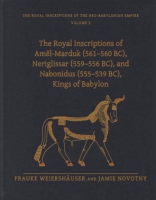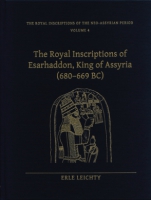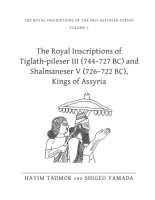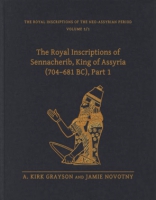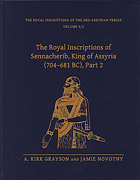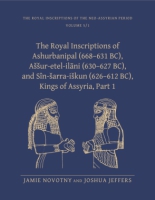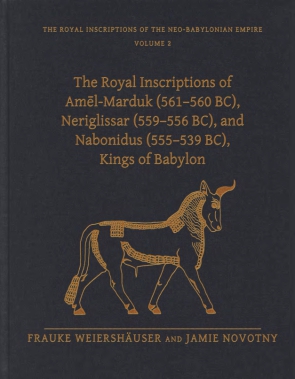
The Royal Inscriptions of Amēl-Marduk (561–560 BC), Neriglissar (559–556 BC), and Nabonidus (555–539 BC), Kings of Babylon
Frauke Weiershäuser and Jamie Novotny
The Royal Inscriptions of Amēl-Marduk (561–560 BC), Neriglissar (559–556 BC), and Nabonidus (555–539 BC), Kings of Babylon
Frauke Weiershäuser and Jamie Novotny
Amēl-Marduk (561–560 BC), Neriglissar (559–556 BC), and Nabonidus (555–539 BC) were the last native kings of Babylon. In this modern scholarly edition of the complete extant corpus of royal inscriptions from each of their reigns, Frauke Weiershäuser and Jamie Novotny provide updated and reliable editions of the texts.
- Description
- Bio
- Table of Contents
- Sample Chapters
- Links
The kings of the Neo-Babylonian Empire left hundreds of official inscriptions on objects such as clay cylinders, bricks, paving stones, vases, and stelae. These writings, ranging from lengthy narratives enumerating the deeds of a monarch to labels identifying a ruler as the builder of a given structure, supplement and inform our understanding of the empire. Beginning with a historical introduction to the reigns of these three kings and the corpus of inscriptions, Weiershäuser and Novotny then present each text with an introduction, a photograph of the inscribed object, the Akkadian text in a newly collated transliteration, an English translation, catalogue data, commentary, and an updated bibliography. Additionally, Weiershäuser and Novotny provide new translations of several related Akkadian texts and chronicles.
Featuring meticulous yet readable transliterations and translations that have been carefully collated with the originals, this book will be the standard edition for scholars and students of Assyriology, the Neo-Babylonian dialect, and the Neo-Babylonian Empire for decades to come.
Frauke Weiershäuser is Tenured Academic Researcher of the Alexander von Humboldt Professorship for the Ancient History of the Near and Middle East at Ludwig-Maximilians-Universität München. She is the primary author on the Royal Inscriptions of the Neo-Babylonian Empire (RINBE) project and author of Die königlichen Frauen der III. Dynastie von Ur.
Jamie Novotny is Tenured Academic Researcher of the Alexander von Humboldt Professorship for the Ancient History of the Near and Middle East at Ludwig-Maximilians-Universität München, Codirector of the Munich Open-Access Cuneiform Corpus Initiative, and Editor-in-Chief of the RINBE project. He is the author, editor, or coauthor of several books, including The Royal Inscriptions of Ashurbanipal (668–631 BC), Assur-etal-ilani (630–627 BC), and Sin-sarra-iskun (626–612 BC), Kings of Assyria: Part I, also published by Eisenbrauns.
Contents
List of Figures
Contents of Scores
Directors’ Foreword
Foreword from the Director of the Vorderasiatisches Museum
Preface
Editorial Notes
Bibliographical Abbreviations
Other Abbreviations
Object Signatures
Introduction
I. Amēl-Marduk
Babylon
Bricks
No. 1 — Brick Inscription (B1)
29
Paving Stone
No. 2 — Paving Stone (PS1)
Stone Vessel
No. 3 — Babylon Vase (V1)
Susa
Stone Vessels
No. 4 — Susa Vase 1 (V2)
No. 5 — Susa Vase 2 (V3)
No. 6 — Susa Vase 3 (V4)
II. Neriglissar
Babylon
Clay Cylinders
No. 1 — Esagil Inscription (C21)
No. 2 — Lībil-ḫegalla Inscription (C22)
No. 3 — Royal Palace Inscription (C23)
Bricks
No. 4 — Brick Inscription (B1)
No. 5 — Brick Inscription (B2)
Sippar
Clay Cylinder
No. 6 — Cylinder Inscription (C022)
Uncertain Provenance (Possibly Borsippa)
Clay Cylinder
No. 7 — Cylinder Inscription (C011)
Susa
Vase
No. 8 — Vase (V1)
III. Nabonidus — Babylonia
Babylon
Clay Cylinders
No. 1 — Imgur-Enlil Cylinder / Cylinder II,1 / Inscription A
No. 2 — Emašdari Cylinder / Cylinder II,3 / Inscription B
Steles
No. 3 — Babylon Stele/ Stele Fragment XI / Inscription 1
No. 4 — Stele Fragments (BE 548+)
Clay Tablet
No. 5 — BM 38770
Paving Stone
No. 6 — Paving Stone U / Inscription H / Nebuchadnezzar II Lb1 2
Bricks
No. 7 — Brick Inscription A I,1 / Inscription C
No. 8 — Brick Inscription AP I,1 / Inscription D
No. 9 — Brick Inscription U / Inscription E
Agade
Clay Cylinders
No. 10 — Eulmaš Cylinder
No. 11 — BE 12586
No. 12 — BE 40133
Borsippa
Clay Cylinder
No. 13 — Ezida Cylinder
Kish
Clay Cylinder
No. 14 — Kish Cylinder
Kissik
Clay Cylinder
No. 15 — Eamaškuga Cylinder / Cylinder II,6 / Inscription 10
Larsa
Clay Cylinder
No. 16 — Larsa Cylinder / Cylinder III,1 / Inscription 9
Stele
No. 17 — Larsa Stele / Fragment 1
Bricks
No. 18 — Brick Inscription Ap I,2 / Inscription 12
Marad
Clay Cylinder
No. 19 — Eigikalama Cylinder / Cylinder II,5 / Inscription 7
Seleucia
Brick
No. 20 — Schaudig, Inschriften Nabonids no. 1.3
Sippar
Clay Cylinders
No. 21 — BM 46600
No. 22 — MMA 86.11.52
No. 23 — Ebabbar Cylinder / Cylinder III,3 / Inscription 11
No. 24 — Ebabbar Cylinder / Cylinder II,9 / Inscription 5
No. 25 — Tiara Cylinder / Cylinder II,8 / Inscription 6
No. 26 — Ebabbar-Ekurra Cylinder / Cylinder II,4, Inscription 8
No. 27 — Cylinder III,4 / Inscription 16
No. 28 — Eḫulḫul Cylinder / Cylinder III,2 / Inscription 15
No. 29 — Eḫulḫul Cylinder (BM 91087)
Tablet
No. 30 — BM 76825
Bricks
No. 31 — Schaudig, Inschriften Nabonids no. 1.1
Ur
Clay Cylinders
No. 32 — Elugalgalgasisa Cylinder / Cylinder II,1 / Inscription 17
No. 33 — Elugalgalgasisa Cylinder (CBS 15617)
No. 34 — En-nigaldi-Nanna Cylinder / Cylinder II,7 / Inscription 2
No. 35 — Ur Cylinder
Stone Door Socket
No. 36 — Door Socket 1 / Inscription 3
Bricks
No. 37 — Brick Inscription B I,2 / Inscription 19
No. 38 — Brick Inscription B I,1 / Inscription 18
No. 39 — Brick Inscription B I,3 / Inscription 4
Uruk
Stele
No. 40 — Uruk Stele
Uncertain Provenance
Clay Cylinders
No. 41 — BM 47814
No. 42 — Da Riva, GMTR 4 p. 131 no. 1c
Stele
No. 43 — Tarif Stele / Stele Fragment 1 / Inscription 14
Clay Tablets
No. 44 — Inscription G
No. 45 — BM 58756
IV. Nabonidus — The Northwest
Ḫarrān
Clay Cylinder
No. 46 — Ḫarrān Cylinder / Fragment 3
Steles
No. 47 — Ḫarrān Stele / Stele Fragments III,1 / Inscription 13
Stone Fragments
No. 48 — Schaudig, Inschriften Nabonids no. 4.5
No. 49 — Schaudig, Inschriften Nabonids no. 4.4
No. 50 — Schaudig, Inschriften Nabonids no. 4.3
Bricks
No. 51 — Fragment 2 (Hr 85/75)
Stone Bowl
No. 52 — SM 899.2.282
Pearl
No. 53 — Pearl Inscription / Inscription F
Padakku
Rock Relief
No. 54 — Padakku Inscription
Selaʾ
Rock Relief
No. 55 — Selaʾ Inscription
Tēmā
Stele
No. 56 — Tēmā Stele
Pedestal
No. 57 — TA 3656 + TA 9208
Stone Fragments
No. 58 — TA 3813
No. 59 — TA 3833
No. 60 — TA 11381
No. 61 — TA 17966
V. Nabonidus — Uncertain Texts
Uncertain Provenance (Possibly Babylon and Borsippa)
Clay Cylinders
No. 1001 — Palace Cylinder / Inscription Z .
No. 1002 — BM 38696
Stele
No. 1003 — VA 3217
Kish
Clay Cylinder
No. 1004 — Cylinder Fragment I,1 / Inscription X
Kissik
Brick
No. 1005 — BM 137452
Sippar
Clay Cylinders
No. 1006 — BM 40076
No. 1007 — BM 40532+
No. 1008 — Stone Wall Cylinder
No. 1009 — Cylinder Fragment I,2 / Inscription Y
No. 1010 — Schaudig, Inschriften Nabonids no. 2.29
Clay Tablet
No. 1011 — BM 76544
VI. Nabonidus — Royal Family
Adad-guppi
Stele
No. 2001 — Adad-guppi Stele
Minor Variants and Comments
Index of Museum Numbers
Index of Excavation Numbers
Index of Names
Concordances of Selected Publications
Scores of Inscriptions (on Oracc)
(a PDF of the scores is available at http://oracc.org/ribo/bab7scores/)
Download a PDF sample chapter here: Introduction
A freely accessible PDF of this book is available via Open Access LMU. Click here.
Annotated (linguistically tagged) and searchable digital editions of the inscriptions included in RINBE 2 (with English and German translations) are also accessible via the ‘Babylon 7’ sub-project of the Oracc-hosted Royal Inscriptions of Babylonia online (RIBo) Project. Click here.
Mailing List
Subscribe to our mailing list and be notified about new titles, journals and catalogs.
